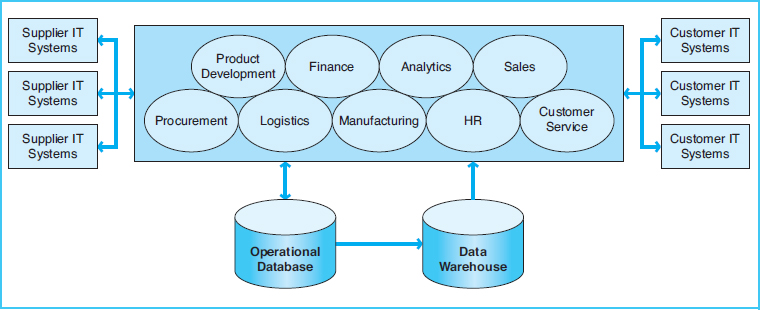CURRENT ERP SYSTEM CHARACTERISTICS (STUDY OBJECTIVE 3)
The evolution of ERP II systems has resulted in most large businesses implementing ERP systems that are connected to the IT systems of their trading partners. EDI, Internet EDI, or extranets are used to connect a company's ERP system to the IT systems of its suppliers and customers. For example, suppliers may monitor their customers' inventory levels and electronically trigger a shipment when items they supply reach pre-arranged reorder levels. Another example of this trading partner connection of ERP systems is that a customer could access a supplier's production schedule to assess when its order may be filled. Exhibit 15-2 depicts a view of an ERP II system. The term “ERP II” has not yet been widely adopted, and the software systems are still generally referred to as ERP systems, even though they have expanded modules and functions compared with the original ERP systems of the 1990s.

Because of the decline in the U.S. stock market following the tragic events of September 11, 2001, nearly all companies made drastic reductions in expenditures on IT systems and software around that time. IT spending on ERP systems was flat between 2001 and 2003. Beginning in 2004, IT spending on ERP systems began to rise again. In the years since 2004, spending on ERP systems increased or decreased based on several factors.
- ERP has become so important to daily operations that many companies cannot allow their ERP systems to become outdated.
- The need to improve customer service through standardizing and combining business processes requires ERP software that can support standardized and combined processes.
- Global companies that operate in several countries may have separate ERP systems in the different countries. Many of these companies decide to replace these various ERP systems with one centrally managed ERP system for the entire company.
- Aging ERP systems that were installed in prior years need replacement to meet competitive demands faced by companies today.
- Bigger IT budgets replace leaner budgets as economic conditions improve. As companies increase overall IT spending, spending on ERP systems also increases.
- Many companies needed upgraded systems to enhance compliance with the Sarbanes–Oxley Act.
- Many companies wanted to take advantage of new technologies such as cloud-based ERP systems.
In spite of these important factors, spending on ERP systems tends to decline during hard economic times. ERP spending is expected to rise over the next few years.
THE REAL WORLD
Viper Motorcycle Company, a Minneapolis-based manufacturer and seller of luxury motor- cycles, began business in 2002. Within one year, Viper was looking for an accounting software system that would tie together the company's accounting with manufacturing, order processing, and other business functions, while complying with Sarbanes–Oxley. Viper first selected SAP Business One® as its ERP software system, and later adopted SAP Business ByDesign.® These IT Solutions have helped Viper realize benefits in terms of operating efficiencies, financial transparency, and setting internal controls.
This section has provided a brief overview of the ERP modules, the databases, and the interactive connection between the ERP system and trading partners. The next section will describe selected ERP modules in more detail.
